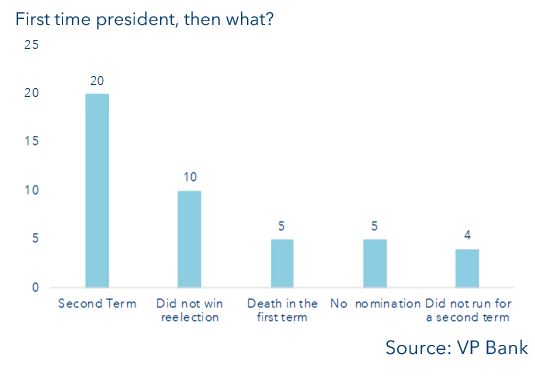Trump sitting tall in the saddle
1. The "incumbent bonus"
“Super Tuesday” on 3 March constitutes the official starting pistol for the race to the White House in November. This year, Super Tuesday will certainly live up to its name. On a single day, primary elections will be held in 14 states plus American Samoa, along with expat Democrats around the globe. And for the first time, California, the most populous US state, will also be in the starting blocks. Once the results from Super Tuesday are in, some 40% of all delegate votes will have been allocated, and by mid-March more than 60%. The person in the lead at that point can justifiably hope to win the nomination by the Democratic Party as presidential candidate. But it will be a tough uphill battle for the Democrats, as Donald Trump has a good chance of being re-elected regardless of who is pitted against him. Four factors argue in favour of this outcome: the incumbent bonus; the “electoral” system, parallels with the UK and betting odds.
A glance at the history books shows that incumbents enjoy an edge. Of the 44 US presidents prior to Trump, 20 managed to win a second term. Only 10 were not re-elected. In six of the ten cases the reason was a weak US economy, a political scandal or an unpopular military engagement. Conversely, if the US economy is in good shape, the president is not tarnished by any ghastly political scandals and the US is not on the war path, the probability of a second term is 60%. This is also reflective of the fact that there is rarely a close call in the Electoral College when it comes to re-electing or voting out a sitting president.

|
The roadmap to inauguration 3 March: Super Tuesday 13 thru 16 July: National Democratic Convention in Milwaukee, Wisconsin; nomination of the party’s presidential candidate 24 thru 27 August: National Republican Convention in Charlotte, North Carolina; official nomination of Donald Trump 3 November 2020: Presidential and congressional elections 14 December 2020: The Electoral College formally elects the US president 20 January 2021: Inauguration of the US president |
2. The "electoral" system
The US president is not elected directly, but rather by so-called “electors” who represent the popular votes of the citizenry. Almost all US states have majority system in place, in other words, the party that achieves a simple majority of the popular vote in a state wins all of its designated electors. They form the “Electoral College” which then conducts the decisive vote. This means that the candidate who receives the most votes from the public does not necessarily become president. In 2016, for example, Donald Trump received 2.8 million fewer popular votes than Democratic candidate Hillary Clinton. Nonetheless, Trump received 306 electoral votes and Clinton only 232. Earlier, George W. Bush also came away the winner in 2000 only thanks to the Electoral College; his Democratic challenger Al Gore had a 550,000 more votes.
Key to the election outcome therefore are the so-called “swing states”. These are states where in the past there has been no clear preference for either party, yet they are entitled to a large number of electors. Swing states are Pennsylvania, North Carolina, Michigan, Arizona, Wisconsin and Florida. Collectively, they account for 101 of the total of 538 electors, with a 270 votes needed to win the presidency. Current polls suggest that the Democrats have pretty much secured 183 electors versus the Republicans’ 125. Nonetheless, the Republicans have a good chance of winning the swing states. So when all is said and done, it cannot be ruled out that Trump actually loses the popular vote again, yet still has a clear majority on his side in the Electoral College.
|
Did you know that… …the term of office of US presidents has been limited to two consecutive four-year periods only since 27 February 1951? In 1940, Franklin D. Roosevelt was the first president to be elected to a third term due to the critical situation during the Second World War. He therefore spent a total of 12 years in office. …four sitting US presidents have been assassinated? These were namely, Abraham Lincoln, James A. Garfield, William McKinley and John F. Kennedy. …Stephen Grover Cleveland was both the 22nd and 24th president of the United States, thereby making him the only US president whose terms of office were not consecutive? |
3. Parallels with the UK
Recent developments in Great Britain could also provide some example. The country is politically divided, just like the USA. British Prime Minister Boris Johnson is polarising the populace the same way as Trump is doing in the USA. What’s more, the British opposition in Parliament is making a weak impression. And in the US, the Democrats have been unable to make hay out of the Trump’s weak approval ratings. The longstanding majority voting system anchored in America’s erstwhile fatherland ultimately carried Boris Johnson to a clear victory in the December 2019 parliamentary elections.
4. Betting odds
PredictIT, a New Zealand-based betting website, offers a slightly different view of the upcoming US presidential election. As a platform for placing wagers on political (and other) events, it is a mixture of a stock exchange and a bookmaker’s shop. Punters are asked concrete questions and can bet money on the possible outcomes. If their prediction comes true, they pocket the winnings. That said, these bets make it possible to derive probabilities – and currently, with a 58% likelihood, the Republican party and thus their presidential candidate Donald Trump will be victorious. We take PredictIT’s metric with a pinch of salt, but the current odds are supportive of our argument here.
The balance of power lies in the congressional elections
Assuming our analysis is correct, nothing stands in the way of a second term for Donald Trump. But then the question begs as to how powerful Trump will be, since his ultimate clout depends on the distribution of seats on Capitol Hill. Because all 435 representatives in the House and one-third of the 100 senators are elected at the same time as the president, the whole deck of cards could be reshuffled. Given that many laws require passage by both chambers of Congress – e.g. any further tax cuts envisioned by Trump – the president is hamstrung unless he is backed by a Republican majority in the House of Representatives. Lacking that, he would be dependent on implementing his plans via executive order, but in a watered-down form.
In the 2018 mid-term elections, the Democrats garnered 235 of the 435 seats in the House, hence the Republicans would have to win back 18 seats this year in order to gain a majority of 218 seats. That is likely to be an uphill battle. The Democrats currently have a clear advantage in 219 constituencies, whilst the Republicans can be relatively confident of keeping 193 seats. In the remaining 23 constituencies, no clear tendency is discernible at this point. However, forecasts suggest that the Democrats will be able to defend their majority in the House of Representatives. As to the Senate, the situation is quite clear: it is considered almost a certainty that the Republicans will retain their majority. So overall, there will be little change in the composition of Congress.
Summary
Even though the leading Democratic presidential candidate will get more ink in the press following “Super Tuesday”, Donald Trump remains tall in the saddle. That an incumbent president is voted out of office is the exception, not the rule. The bottom line: If the current occupant of the Oval Office can avoid any major political faux pas, and the US economy stays on course, the re-election of the “Twitter President” is rather likely.
Important legal information
This document was produced by VP Bank AG (hereinafter: the Bank) and distributed by the companies of VP Bank Group. This document does not constitute an offer or an invitation to buy or sell financial instruments. The recommendations, assessments and statements it contains represent the personal opinions of the VP Bank AG analyst concerned as at the publication date stated in the document and may be changed at any time without advance notice. This document is based on information derived from sources that are believed to be reliable. Although the utmost care has been taken in producing this document and the assessments it contains, no warranty or guarantee can be given that its contents are entirely accurate and complete. In particular, the information in this document may not include all relevant information regarding the financial instruments referred to herein or their issuers.
Additional important information on the risks associated with the financial instruments described in this document, on the characteristics of VP Bank Group, on the treatment of conflicts of interest in connection with these financial instruments and on the distribution of this document can be found at https://www.vpbank.com/legal_notes_en.pdf



Add the first comment